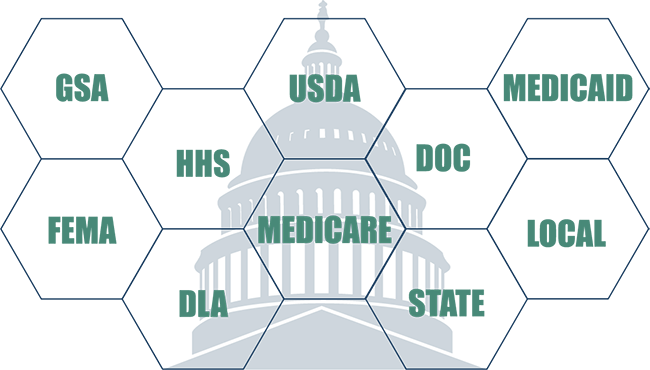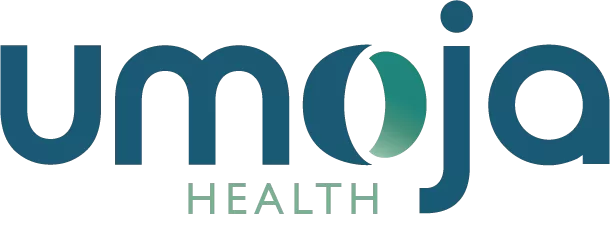Government Programs
Local, Regional, State and Federal Agency Solutions

With national reach and flexible solutions, we can meet the needs of small- and large-scale government programs
Our expertise in food, logistics, and supply chain management allows us to provide valuable, cost-efficient, transparent, and scalable solutions for local, regional, and federal government entities. We work with agencies of all sizes on sourcing and procurement of food and non-food products at scale, meal kitting and direct delivery services for feeding programs, consolidating of goods for effective distribution, and efficient solutions to logistics and supply chain challenges.
At Umoja, we tailor our solutions to meet the unique challenges and requirements of government business. With a proven track record of delivering on-time, on-budget, on-spec with a wide range of programs, our team is ready to provide the right solution to serve communities across the country.
How We Can Help You
With our network of manufacturing partners, we can provide a wide range of products including distribution-ready meal kits, shelf stable foods, produce, commodities and non-food items for Federal, State, and Local programs.
- Nutritional security and access to essential foods
- Scalable sourcing & procurement of a wide range of food, meals, beverages, household, hygiene products and more
- Development of tailored products through our network of manufacturing partners
- Consolidation, distribution and warehousing solutions
- National and global logistics & supply chain expertise
- Food-As-Medicine nutrition programs for Medicare and Medicaid recipients
- Forward buying
- Emergency response solutions
Read More
Comprehensive Government Program Support and Implementation
Federal nutrition programs serve over 50 million Americans annually through various food assistance initiatives. State and local agencies manage implementation while navigating complex regulatory requirements and budget constraints.
Program administration involves multiple stakeholders including federal agencies, state governments, local organizations, and community partners. Coordination between these entities requires specialized knowledge of regulatory frameworks and operational best practices.
Budget cycles affect program planning and implementation significantly. Federal appropriations set annual funding levels. State budgets determine matching fund availability. Local organizations must plan operations around these funding timelines and restrictions.
Federal Program Compliance and Oversight
Child Nutrition Programs require precise documentation for reimbursement eligibility. Meal pattern compliance, attendance tracking, and financial reporting must meet federal standards. Audit requirements create additional administrative burden for participating organizations.
TEFAP (The Emergency Food Assistance Program) distribution follows specific guidelines for eligible organizations and approved foods. State agencies allocate commodities based on need assessments and historical distribution patterns. Documentation requirements track food movement from federal warehouses through final distribution.
WIC program operations involve complex coordination between state agencies, local clinics, and authorized retailers. Benefit issuance, nutrition education, and vendor management require integrated systems and trained staff. Technology upgrades and regulatory changes create ongoing training needs.
Food Distribution Program on Indian Reservations (FDPIR) serves tribal communities with unique cultural and geographic considerations. Remote locations, limited infrastructure, and cultural food preferences require specialized distribution approaches.
Emergency Response and Disaster Relief Operations
Natural disasters disrupt normal food distribution systems while increasing need for emergency assistance. Hurricane evacuations, wildfire displacements, and flood damage create immediate feeding requirements that exceed normal program capacity.
Rapid response capabilities require pre-positioned inventory, established distribution networks, and trained personnel ready for immediate deployment. FEMA coordination, state emergency management partnerships, and local response teams must work seamlessly during crisis situations.
Supply chain flexibility becomes critical during emergency operations. Normal procurement procedures may be suspended. Transportation routes might be disrupted. Alternative suppliers and distribution methods need quick activation protocols.
Commodity Distribution and Inventory Management
USDA commodity allocation follows complex formulas based on poverty rates, unemployment statistics, and historical usage patterns. State agencies must distribute allocations fairly while accounting for local capacity and transportation limitations.
Storage requirements for government commodities exceed commercial standards in many cases. Temperature control, pest management, and security protocols protect public investments while ensuring food safety. Documentation tracks commodity movement throughout distribution networks.
Inventory rotation prevents waste while maintaining quality standards. First-in-first-out protocols ensure older products ship before newer arrivals. Expiration date monitoring prevents distribution of outdated products while maximizing utilization rates.
Quality assurance procedures verify commodity conditions throughout the supply chain. Incoming inspections identify damaged products before distribution. Regular sampling tests verify continued quality during storage periods.
Procurement and Vendor Management
Government procurement follows strict competitive bidding procedures designed to ensure fairness and maximize value. Request for Proposal (RFP) development, bid evaluation, and contract award processes require detailed documentation and transparent procedures.
Vendor qualification involves financial stability assessments, operational capability reviews, and past performance evaluations. Food safety certifications, insurance requirements, and bonding capacity must meet government standards before contract eligibility.
Contract administration ensures ongoing compliance with specifications, delivery schedules, and performance standards. Regular monitoring, performance evaluations, and corrective action procedures maintain accountability throughout contract periods.
Cost-Effectiveness and Budget Management
Unit cost analysis helps agencies maximize purchasing power while meeting program requirements. Volume discounts, seasonal pricing variations, and market conditions affect procurement strategies significantly.
Administrative cost limitations require efficient operations while maintaining program quality. Overhead expenses, staffing levels, and operational procedures must balance cost control with service delivery requirements.
Financial reporting requirements track expenditures against budgets while documenting compliance with federal guidelines. Monthly reports, quarterly reviews, and annual audits ensure fiscal responsibility and program integrity.
Performance metrics demonstrate program effectiveness while identifying improvement opportunities. Participation rates, cost per meal, and customer satisfaction surveys provide data for continuous program enhancement.
Government food programs represent critical safety nets that require professional management, regulatory compliance, and operational excellence to serve vulnerable populations effectively while maintaining public trust and fiscal responsibility.

Programs
The range of federal and state programs focused on food and nutrition are designed around providing food and nutrition access to underserved and vulnerable populations.
USDA FNS Child and Adult Nutrition Programs (SFSP and CACFP)
The Emergency Food Assistance Program (TEFAP)
Women, Infants, and Children (WIC)
Local Food Purchase Assistance (LFPA)
Food Distribution Program on Indian Reservations (FDPIR)
Food Distribution Program on Indian Reservations (FDPIR)
Older Americans Act (OAA) Compliant Products
Contact our government services team today
With broad food sourcing capabilities, supply chain and logistics expertise, food-as-medicine grocery delivery programs for public insurers and providers, disaster response and forward buying solutions, and more, let us help you help your communities.
